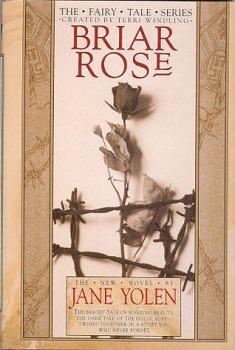 Eric Eller wrote this review.
Eric Eller wrote this review.
Though fairy tales were originally told to adults, they became a traditional literature for children and lost much of their original message for grown people.
However, the best ones retain an ability to entertain adults and children alike. Instead of a basic ‘for children of all ages’ theme, a well-crafted fairy tale communicates different levels of truth, depending on the audience. A basic theme that entertains children yields to a more complex interpretation and lessons for adults.
In Briar Rose, Jane Yolen’s reinterpretation of the story of Sleeping Beauty, the reader is entertained in just this manner. Framed around Rebecca Berlin’s childhood memories of her grandmother’s repeated recital of Sleeping Beauty is a somber retelling of the myth with the Holocaust and the death camp of Chelmno as the setting. The book blends together two story lines in alternating chapters. In the odd-numbered chapters Rebecca’s grandmother tells her version of Sleeping Beauty repeatedly throughout the childhood of Rebecca and her two older sisters. The even-numbered chapters describe the adult Rebecca’s journey to discover the truth behind her grandmother’s claims that the story was real and that she was the princess in it. The two tracks run in parallel, with each segment told by Rebecca’s grandmother keeping pace with the discoveries Rebecca makes about the truth behind the tale.
Rebecca’s journey to discover the truth about her grandmother begins with a deathbed promise to confirm that her grandmother really was Sleeping Beauty. The first clues are discovered when the family goes through the last of Rebecca’s grandmother’s things. Rebecca finds clues to her grandmother’s past and possibly to the identity of her grandfather, along with hints of a strong link to parts of the Sleeping Beauty story. The information Rebecca discovers leads her to former refugees who escaped Nazi-occupied Europe during World Ware II. Here she meets someone who knew her grandmother at the end of the war. She also picks up clues which lead her to Poland and ultimately to Chelmno, the site of a death camp where the Nazis slaughtered over 300,000 people.
Briar Rose evokes all of the emotion that a true fairy tale should. The language is very moving, describing events in World War II in words that are both shocking and uplifting, while still preserving something of a fairy tale’s magic. The buildup of the story told to the children, paralleling Rebecca’s discovery of the true events, draws a powerful emotional response out of the reader. The contrast between the fairy tale and Rebecca’s visit is startling. The passing off of ordinary and horrifying events, mixed in with the parallel telling of the fairy tale, links the stories together to lead to a denouement where Rebecca discovers the real basis of her grandmother’s story.
Though the chain of events and contacts that allow Rebecca to discover her grandmother’s past are all plausible, the only weaknesses in the story are the two crucial connections Rebecca makes with people who knew her grandmother. The initial link, made with a former refugee who is in an old photo Rebecca has of her grandmother, is the more tenuous of the two. The second chance encounter that drives the plot forward, meeting the priest in Chelmno who knows the ‘prince’ from the real events behind the story, is only slightly more plausible. These chance encounters move the story along much faster than might realistically be expected when one researches family history. However, given the enormity of the task that Rebecca faces, these fortuitous meetings can be overlooked. Otherwise, there would have been little chance of her succeeding in finding out about her grandmother and thus no resolution to the novel.
The book reads quickly. The prose is straightforward and somewhat stripped down, but the story’s power propels the reader through to the end. For example, the Polish residents of Chelmno are drawn sparely, but the darkness in their past is evident through the writer’s ability to elicit vivid feelings from the reader when the local priest describes his experiences in Chelmno. Familiarity with the Holocaust and World War II is not needed to fully enjoy the book. I felt that detailed background knowledge actually distracted from the story, since it encouraged the early drawing of conclusions about how the book would end.
The characters in the ‘true’ version of the stories are realistically drawn, despite the difficult and almost unimaginably terrible setting. Josef, Avenger, the Rebbe, and the others are not written as one-dimensional heroes or villains, as could easily have been done to drive home the horror of the Holocaust. Instead, each character is more human, shown with his or her failings and good points together. The events of the story have a stronger emotional impact due to the multidimensional characters.
Briar Rose tells a story about the Holocaust that communicates all of the horror in a way that maintains a sense of hope that even the worst of circumstances can sometimes be overcome. However, the fictional happy ending for Rebecca is brought back to reality by the simple facts of the extermination that took place at Chelmno and the truth that history gives no true happy endings. The hopeful tone of the book is balanced in the Afterward with a brief and sober look at the facts of Chelmno. This strengthens the fairy tale aspect of the book itself. A fairy tale may have a happy ending, but the truth behind one is not as happy. Briar Rose succeeds by conveying both of these points, in a story that is powerful and at times uplifting, but ultimately wrenching. Like any good fairy tale, the story and its lessons stay with the reader well beyond the end of the book.
(Tor, 1993 and 2016; Econo-Clad Books, 1999)
